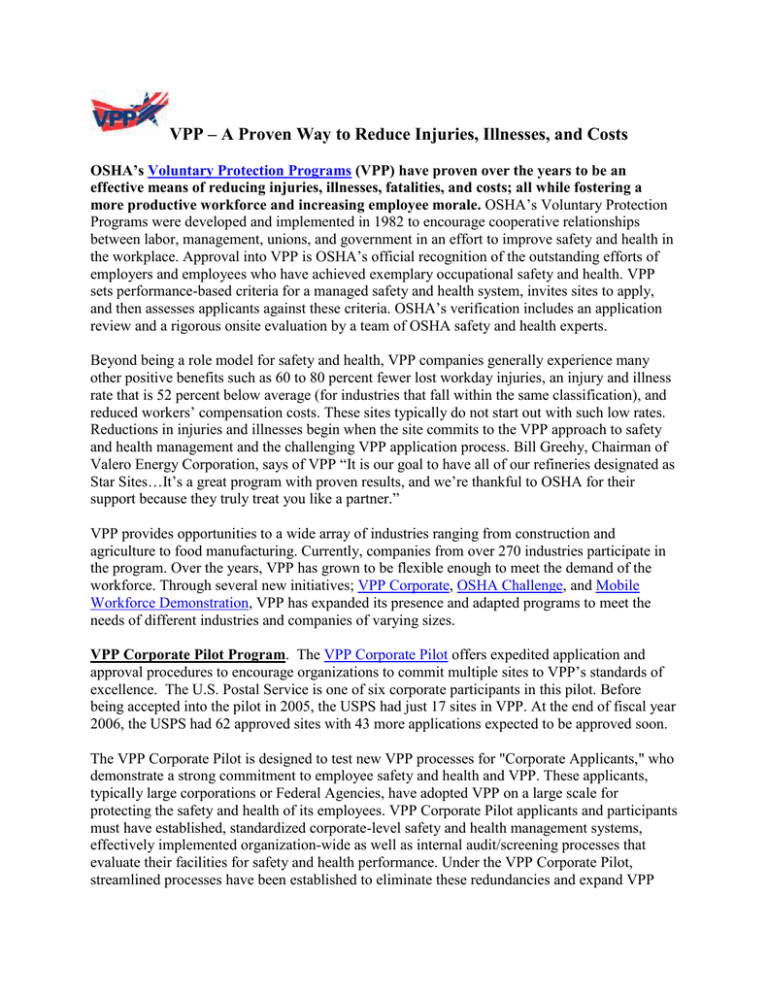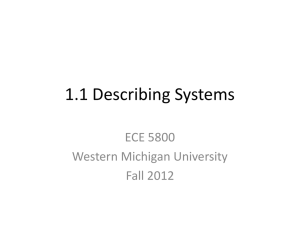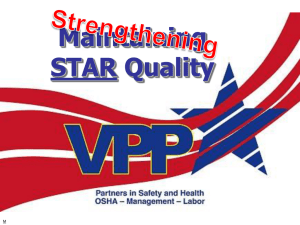VPP – A Proven Way to Reduce Injuries, Illnesses, and...
advertisement

VPP – A Proven Way to Reduce Injuries, Illnesses, and Costs OSHA’s Voluntary Protection Programs (VPP) have proven over the years to be an effective means of reducing injuries, illnesses, fatalities, and costs; all while fostering a more productive workforce and increasing employee morale. OSHA’s Voluntary Protection Programs were developed and implemented in 1982 to encourage cooperative relationships between labor, management, unions, and government in an effort to improve safety and health in the workplace. Approval into VPP is OSHA’s official recognition of the outstanding efforts of employers and employees who have achieved exemplary occupational safety and health. VPP sets performance-based criteria for a managed safety and health system, invites sites to apply, and then assesses applicants against these criteria. OSHA’s verification includes an application review and a rigorous onsite evaluation by a team of OSHA safety and health experts. Beyond being a role model for safety and health, VPP companies generally experience many other positive benefits such as 60 to 80 percent fewer lost workday injuries, an injury and illness rate that is 52 percent below average (for industries that fall within the same classification), and reduced workers’ compensation costs. These sites typically do not start out with such low rates. Reductions in injuries and illnesses begin when the site commits to the VPP approach to safety and health management and the challenging VPP application process. Bill Greehy, Chairman of Valero Energy Corporation, says of VPP “It is our goal to have all of our refineries designated as Star Sites…It’s a great program with proven results, and we’re thankful to OSHA for their support because they truly treat you like a partner.” VPP provides opportunities to a wide array of industries ranging from construction and agriculture to food manufacturing. Currently, companies from over 270 industries participate in the program. Over the years, VPP has grown to be flexible enough to meet the demand of the workforce. Through several new initiatives; VPP Corporate, OSHA Challenge, and Mobile Workforce Demonstration, VPP has expanded its presence and adapted programs to meet the needs of different industries and companies of varying sizes. VPP Corporate Pilot Program. The VPP Corporate Pilot offers expedited application and approval procedures to encourage organizations to commit multiple sites to VPP’s standards of excellence. The U.S. Postal Service is one of six corporate participants in this pilot. Before being accepted into the pilot in 2005, the USPS had just 17 sites in VPP. At the end of fiscal year 2006, the USPS had 62 approved sites with 43 more applications expected to be approved soon. The VPP Corporate Pilot is designed to test new VPP processes for "Corporate Applicants," who demonstrate a strong commitment to employee safety and health and VPP. These applicants, typically large corporations or Federal Agencies, have adopted VPP on a large scale for protecting the safety and health of its employees. VPP Corporate Pilot applicants and participants must have established, standardized corporate-level safety and health management systems, effectively implemented organization-wide as well as internal audit/screening processes that evaluate their facilities for safety and health performance. Under the VPP Corporate Pilot, streamlined processes have been established to eliminate these redundancies and expand VPP participation for "Corporate Applicants" in a more efficient manner. Upon acceptance of the participant into VPP Corporate, all eligible participant facilities will follow the streamlined application and onsite evaluation process when applying for VPP. General Electric and Dow Chemical Company are among a handful of charter participants in the pilot. Stephen Ramsey, Vice President of Corporate Environmental Programs for General Electric, remarked “GE is honored to be accepted into the OSHA VPP Corporate Program and looks forward to continuing our cooperative and productive relationship with OSHA.” OSHA Challenge. Over the years, many employers have asked for a program that caters specifically to organizations that are interested in the Voluntary Protection Programs but that need some help in meeting VPP requirements. Our new offering, the OSHA Challenge Pilot, aims to satisfy this need. Although Challenge is open to companies of all sizes, smaller companies find Challenge especially helpful in preparing themselves for VPP. Fifty Eight percent of Challenge participants employ fewer than 200 people. OSHA Challenge recognizes that there are many employers at different stages in the process of working towards implementing a successful safety and health management system. OSHA Challenge provides opportunities for employers not currently served by existing OSHA cooperative programs to work with the Agency and receive recognition for their efforts. Challenge Participants link into either a General Industry or a Construction track. Within each track, Participants follow a detailed three-stage roadmap that guides them to improve their safety and health management systems and work toward VPP status. OSHA Challenge Participants that have been in the program a year or more on average have reduced their TCIR and DART Rates 37 % and 31% respectively. OSHA Challenge has become a pipeline for participants to reach for the VPP Star. Mobile Workforce Demonstration. OSHA's newest component of its premiere cooperative program — the VPP Mobile Workforce Demonstration for Construction was launched in October 2006. Edwin G. Foulke, Assistant Secretary of Labor for Occupational Safety and Health, said the program "offers construction employers with mobile construction workforces and short term projects the same opportunity for recognition that fixed-site employers receive" and "recognizes those construction companies that should be held up as models of safety and health for the rest of the industry." This Demonstration is intended to create greater opportunity for employers and employees in the construction industry to participate in VPP and, in so doing, to strengthen worker protections significantly. It will also give OSHA more opportunities to explore and test appropriate modifications to VPP, alternative requirements that will help us bring the benefits of this program to the construction industry. OSHA believes this new Demonstration will work for both companies that typically function as controlling general contractors and companies that perform specialty trade functions, regardless of size. While the core of the new program continues to be effective safety and health management systems, there are important differences (compared to site-based VPP participants) aimed to provide some flexibility for construction participants. The Demonstration program involves a two-phased OSHA verification process: (1) a review of safety and health management system policies and procedures, plus management's commitment to safety and health and VPP; and (2) a visit to one or more worksites to determine the successful implementation of the corporate policies and procedures, and to verify employee involvement. For more information on the VPP, please contact OSHA's Office of Partnerships and Recognition at (202) 693-2213 or visit www.osha.gov/vpp.






